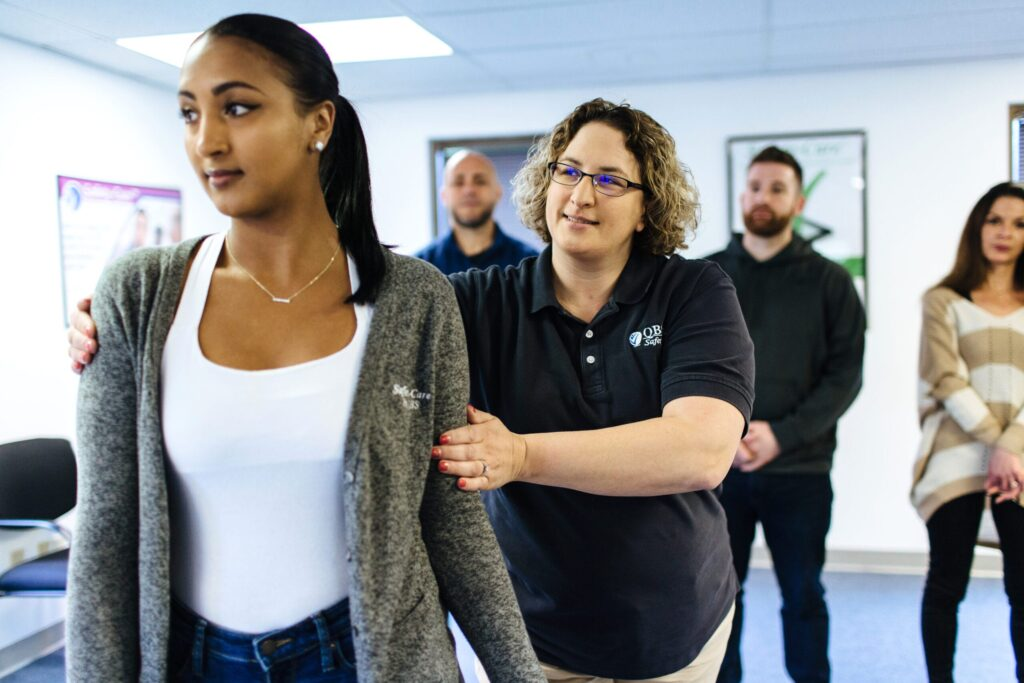Kentucky House Bill 176 – Workplace Safety Policy for Health Care
Beginning in 2024, all health care facilities in the state of Kentucky are directed to develop and operate a workplace in an effort to identify and reduce the risk of violence in the workplace. Training is to be provided to all personnel working and volunteering in such facilities.

.png?width=88&height=95&name=Group%20137%20(5).png)


How to Implement Safety-Care?
1. Register for a Safety-Care Trainer class or call us to request a closed session for your organization. We regularly conduct classes in all 50 states and Canada.
2. Complete your class to become a certified Safety-Care Trainer for your organization. We bring you to fluency using an errorless teaching methodology.
3. You train and certify your staff in Safety-Care’s effective techniques.
4. Our Master Trainers are available by phone, email, or video to help your organization with any questions or concerns while using or implementing Safety-Care.

Legal Requirements
|
Summary: State of Kentucky House Bill No. 176 Effective: January 1, 2024 Last Updated: December, 2024 Beginning in 2024, all health care facilities in the state of Kentucky are directed to develop and operate a workplace in an effort to identify and reduce the risk of violence in the workplace. Training is to be provided to all personnel working and volunteering in such facilities. How Safety-Care aligns: Numerous health care organizations throughout the United States and Canada rely upon QBS and our Safety-Care training to provide their staff members with the training they need to help maintain a safe and healthy environment. Safety-Care provides a comprehensive, supportive approach to incident prevention, de-escalation, and management. Your Staff will learn practical strategies for helping students that use evidence-based practices consistent with PBIS (Positive Behavior Interventions and Supports) and ABA (Applied Behavior Analysis). |
|
SECTION 3: Health facilities shall develop and execute a workplace safety assessment to identify the risk of workplace violence against health care workers and create a workplace safety plan to address the risks identified in the assessment. How Safety-Care aligns: Safety-Care can be a vital part of any developed workplace violence prevention plan. Safety-Care is uniquely designed to provide trainees with the skills to assess potential crises, how de-escalate these situations, and how to respond if the situation is elevated. Our trainings are trauma-informed and focus on modifying behavior to prevent dangerous outcomes. Safety-Care is focused on encouraging positive behavior prior to the use of any other intervention strategy. Our approach stems from the use of Positive Behavior Intervention and Supports (PBIS) that can prevent and manage challenge behavior. |
|
SECTION 4: (1) By January 1, 2024, and at least annually thereafter, each health facility shall provide violence prevention training to all health care workers, volunteers, and contracted security personnel. How Safety-Care aligns: Safety-Care as a training program can be tailored to meet the needs of multiply organizations and professions. All Safety-Care offerings are trauma-informed and utilize PBIS and ABA to ensure that all trainees are equipped with the appropriate responses to challenging behaviors. Additionally, add-on trainings can be provided for unique situations to your facility. (2) The method and frequency of the training may vary according to the information and strategies identified in the workplace safety plan developed pursuant to Section 3. How Safety-Care aligns: Safety-Care is initially taught over a three day period and requires renewal courses once a year. Our program is also under constant evaluation to ensure that it matches with the most current research in de-escalation, positive behavior reinforcements, and safety protocols. (4) Trainings may include but are not limited to: (a) Interactive Q&A How Safety-Care aligns: Safety-Care is primarily taught through verbal and role-play methods to ensure that trainees have hands on experience with the physical management techniques that are used. Other methods are available, please request information when contacting QBS. (5) Trainings shall address the following topics, as appropriate, and shall be based upon the hazards identified in the safety assessment: (a) Behavioral predictors of violence How Safety-Care aligns: As part of our focus on de-escalation, Safety-Care uses a “De-Escalation Staircase” format. This staircase is used to describe how an individual can move up and down from a state of calm to a state of crisis, where violence is possible. As part of the discussion on the staircase, behavioral predictors are reviewed. Safety-Care strategies can then be used to move an individual down the staircase back to a state of calm. (c) De-escalation techniques to minimize violent behavior How Safety-Care aligns: Safety-Care certified individuals are trained to use our Help, Prompt, and Wait strategies as early intervention procedures that effectively de-escalate potential crisis situations before any physical management is necessary. Safety-Care is also based on Applied Behavior Analysis practices and regularly updated with the most current research. This ensures that your staff is fully trained in a system that is focused on de-escalation and is fully trauma-informed. (d) Strategies to prevent physical harm with hands-on practice or role-play How Safety-Care aligns: Role-play is a significant aspect of Safety-Care training. All physical management techniques are role-played by trainees to ensure that they fully grasp the need for minimum restriction and full safety of all participants. Our Master Trainers verify each trainees use of these techniques in role-play, further ensuring their safe use. Each trainee must prove mastery of proper technique use before they can be certified in Safety-Care. Safety-Care prohibits the use of chemical restraints. (f) The process to document and report incidents How Safety-Care aligns: Safety-Care supports and provides common terminology for a comprehensive system of incident reporting, data collection, post-incident debriefing, and analysis in order to best support students following an incident and provide educators with the tools they need to most effectively plan for and prevent similar incidents in the future. Safety-Care trainees also have access to Trainer Connect, a record keeping system that can be used to supplement reporting requirements. (6) Health facilities shall develop and execute a basic protective skills competency test for health care workers, volunteers, and contracted security personnel based on the material provided in the training. How Safety-Care aligns: Prior to certification, each Safety-Care trainee must pass written assessments regarding the training materials as well as a physical assessment on the use of physical management techniques. The full training program is designed to align with all levels an organization and can be taught to staff, administration, and volunteers. |
|
SECTION 5: (1) Health facilities shall develop an internal reporting system for acts of workplace violence committed against a health care worker, patient, or visitor on the health facility’s premises, and shall train health care workers on the proper reporting procedure. How Safety-Care aligns: Safety-Care supports and provides common terminology for a comprehensive system of incident reporting, data collection, post-incident debriefing, and analysis in order to best support students following an incident and provide educators with the tools they need to most effectively plan for and prevent similar incidents in the future. Safety-Care trainees also have access to Trainer Connect, a record keeping system that can be used to supplement reporting requirements. Continuing Education Information How Safety-Care aligns: All Safety-Care certifications last for one year and must be renewed annually in coordination with a Safety-Care Master Trainer. |
Why Safety-Care?
Benefits & Differentiators
In addition to Safety-Care being highly cost-effective, you get:

Skills to effectively prevent, minimize, & manage behavioral challenges with dignity, safety, & the possibility of change

Decreases in staff and patient injuries and reduction in restraint & seclusion time

Instructional procedures based on decades of evidence-based research & compatible with ABA, PBIS & reinforcement-based environments

Customizable program for your setting, staff & clientele, with a strong focus on preventative via non-intrusive, replacement behaviors

Extremely rigorous standards grounded in errorless teaching methodology

Small, intimate class sizes backed by unlimited support & resources
How Is Safety-Care So Effective?
A Genuine Focus on Implementing & Managing Positive Behavioral Skills
Proactive, environmental management recommendations
Understanding of evocative effects of staff behavior
In-depth analysis of antecedents and proactive antecedent interventions
Evidence-based reinforcement procedures
Required competency in de-escalation skills
Humane, non-invasive touch and QBS Check™ strategies
Evidence-based teaching procedures
Applicable to a wide array of settings, conditions & challenging behavior





